6 Tips for Off-Season Fireplace & Chimney Maintenance
 There’s a lot going on in the spring and summer, but smart homeowners use a little of this time to see to some very important chimney- and fireplace-related tasks. Here are six useful tips for making sure your fireplace is ready to run when it gets cold.
There’s a lot going on in the spring and summer, but smart homeowners use a little of this time to see to some very important chimney- and fireplace-related tasks. Here are six useful tips for making sure your fireplace is ready to run when it gets cold.
Tip 1: Inspection and cleaning. No fireplace should be operated without an annual cleaning and inspection by a certified chimney sweep. It’s good to arrange for this service during the off season, when service personnel aren’t usually as busy as they are right before the cold season begins.
A chimney and fireplace inspection covers all the components from the chimney cap and flashing to the chimney’s building materials, the flue and the firebox. Inspections often turn up minor damage – such has small cracks in the brick and mortar of the chimney – that a homeowner normally wouldn’t notice. By catching problems early, solutions can be implemented to prevent dangerous and expensive damage down the line.
For all fireplaces, but wood-burning units in particular, a thorough cleaning is critical to the safe and efficient operation of the appliance. Creosote and soot buildup within the flue can eventually ignite, causing a fire in the chimney that very possibly could spread to surrounding parts of the house. Additionally, some chimneys are filled with debris and little animals alive and dead, and these obstructions can impede the exhaust of smoke and carbon monoxide.
Tip 2: Check the chimney cap. Homeowners can do a chimney cap inspection at any time. You’re mainly looking for broken or torn mesh that can let debris or animals in as well as a loose or incomplete seal.
Tip 3: Inspect the damper. This is another simple inspection homeowners can do in the off season as well as periodically during the winter. The damper should create a very tight seal when closed and should be able to open all the way. A partially opened damper can create serious drafting problems.
Tip 4: The wood you use. When getting your initial supply of wood before winter sets in, always go for seasoned hardwoods, which will create much less smoke and creosote than wet or softwoods. Popular hardwood varieties include oak, ash, birch, sycamore and beech. These woods burn hotter and longer than softwoods like pine, spruce and larch.
Tip 5: Keep the wood pile away from your home. Stacks of wood attract insects such as termites, fleas and other parasites. If your wood is too close to your home, these bugs could find their way inside.
 Tip 6: Inspect gas lines. For gas fireplaces, you should have a professional inspect the lines for leaks and to make sure the lines are generally fitted correctly and not showing signs of damage.
Tip 6: Inspect gas lines. For gas fireplaces, you should have a professional inspect the lines for leaks and to make sure the lines are generally fitted correctly and not showing signs of damage.
By following these tips, you’ll ensure that your fireplace and chimney are ready to go once it’s time to start using them regularly.
If it’s time for inspection and cleaning, Hudson Valley Chimney of Poughkeepsie, N.Y., is ready to help with service and results you can count on. To schedule an appointment or get your questions answered, give us a call at (845) 471-1071.





